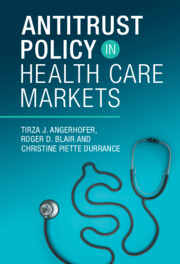Book contents
- Antitrust Policy in Health Care Markets
- Antitrust Policy in Health Care Markets
- Copyright page
- Dedication
- Contents
- Figures
- Tables
- Acknowledgments
- Table of Cases
- 1 Health Care Markets and Competition Policy
- 2 Antitrust Policy in the United States
- Part I Monopoly
- Part II Seller Cartels
- Part III Monopsony
- Part IV Buyer Cartels
- 14 Collusion in the Nurse Labor Market
- 15 Collusion in the Oocyte Market
- 16 No-Poaching Agreements and Antitrust Policy
- Part V Mergers and Acquisitions
- Index
- References
15 - Collusion in the Oocyte Market
from Part IV - Buyer Cartels
Published online by Cambridge University Press: 24 November 2022
- Antitrust Policy in Health Care Markets
- Antitrust Policy in Health Care Markets
- Copyright page
- Dedication
- Contents
- Figures
- Tables
- Acknowledgments
- Table of Cases
- 1 Health Care Markets and Competition Policy
- 2 Antitrust Policy in the United States
- Part I Monopoly
- Part II Seller Cartels
- Part III Monopsony
- Part IV Buyer Cartels
- 14 Collusion in the Nurse Labor Market
- 15 Collusion in the Oocyte Market
- 16 No-Poaching Agreements and Antitrust Policy
- Part V Mergers and Acquisitions
- Index
- References
Summary
Collusion among buyers is every bit as objectionable on social welfare grounds as collusion among sellers. In this chapter, we focus on the antitrust claims in Kamakahi v. American Society of Reproductive Medicine, which arose from collusion among buyers of human eggs (oocytes), which were comprised of fertility clinics and donor agencies. Two closely related trade associations organized and orchestrated a price-fixing conspiracy aimed at depressing the fees paid to egg donors. The antitrust victims were women who were underpaid for the eggs that they donated to fertility clinics or donor agencies. The collusion among fertility clinics would seem to warrant harsh treatment under Section 1 of the Sherman Act. While this case raises important issues in medicine, public health, eugenics, and ethics, we focus our analysis on the merits of the antitrust claim and the effect on the competitive process.
Keywords
- Type
- Chapter
- Information
- Antitrust Policy in Health Care Markets , pp. 345 - 367Publisher: Cambridge University PressPrint publication year: 2022

